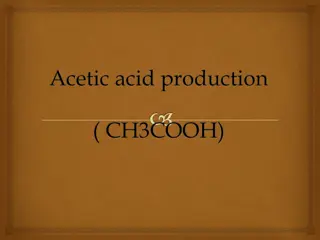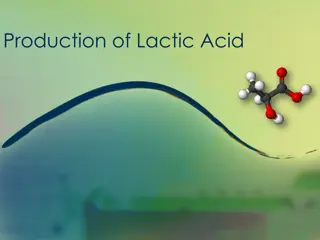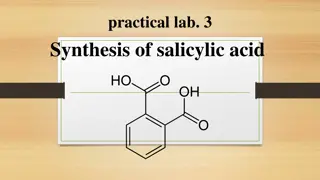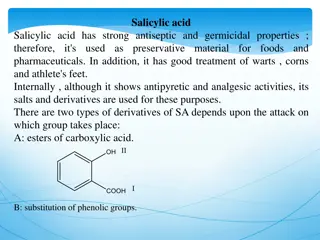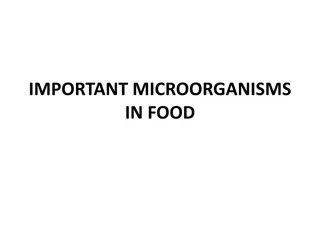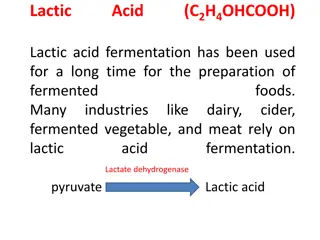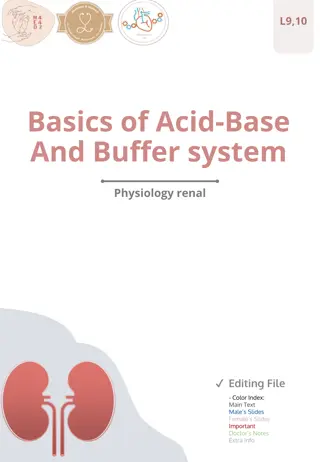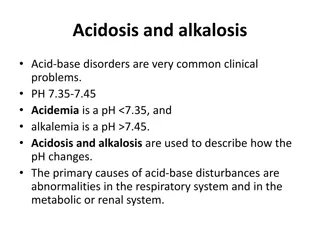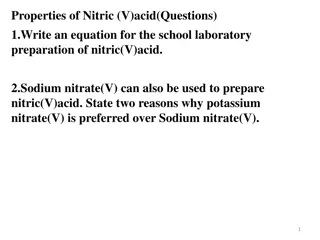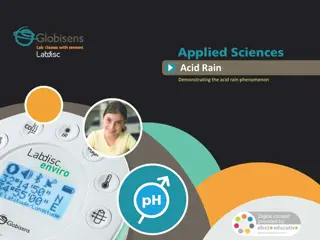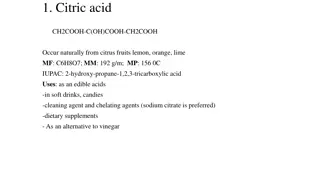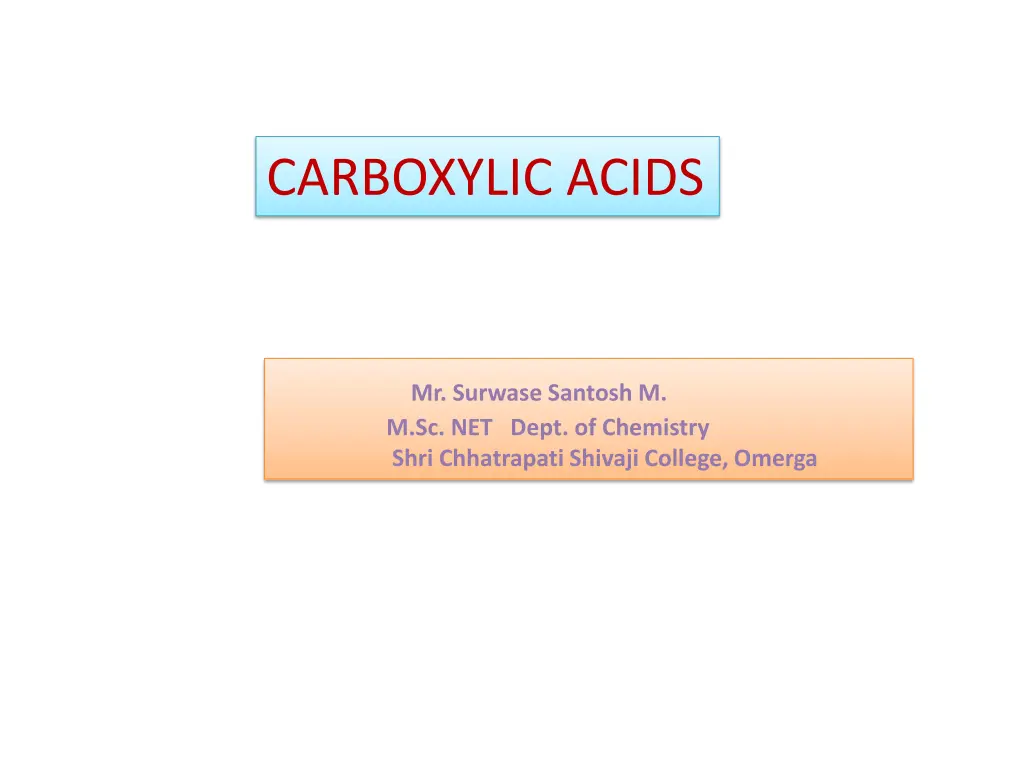
Understanding Carboxylic Acids and Their Acidity
Explore the importance of carboxylic acids, their naming conventions, acidity levels, and factors influencing acid strength. Learn about the pKa values, inductive effects, and substituent influences on carboxylic acids. Dive into the world of organic chemistry with insights from Mr. Surwase Santosh M. Sc. NET, an expert from the Dept. of Chemistry at Shri Chhatrapati Shivaji College, Omerga.
Download Presentation

Please find below an Image/Link to download the presentation.
The content on the website is provided AS IS for your information and personal use only. It may not be sold, licensed, or shared on other websites without obtaining consent from the author. If you encounter any issues during the download, it is possible that the publisher has removed the file from their server.
You are allowed to download the files provided on this website for personal or commercial use, subject to the condition that they are used lawfully. All files are the property of their respective owners.
The content on the website is provided AS IS for your information and personal use only. It may not be sold, licensed, or shared on other websites without obtaining consent from the author.
E N D
Presentation Transcript
CARBOXYLIC ACIDS Mr. Surwase Santosh M. M.Sc. NET Dept. of Chemistry Shri Chhatrapati Shivaji College, Omerga
The Importance of Carboxylic Acids (RCO2H) Starting materials for acyl derivatives (esters, amides, and acid chlorides) Abundant in nature from oxidation of aldehydes and alcohols in metabolism Acetic acid, CH3CO2H, - vinegar Butanoic acid, CH3CH2CH2CO2H (rancid butter) Long-chain aliphatic acids from the breakdown of fats 2
20.1 Naming Carboxylic Acids and Nitriles Carboxylic Acids, RCO2H If derived from open-chain alkanes, replace the terminal - e of the alkane name with -oic acid The carboxyl carbon atom is C1 Based on McMurry, Organic Chemistry, Chapter 20, 6th edition, (c) 2003 3
Acidity of Carboxylic Acids. The pKa of carboxylic acids typically ~ 5. They are significantly more acidic than water or alcohols. Bronsted Acidity : Carboxylic acids transfer a proton to water to give H3O+ and carboxylate anions, RCO2 [RCO2-] [H3O+] [RCO2H] Ka= pKa= - log Ka typically ~ 10-5 for carboxylic acid typically ~ 5 for carboxylic acid CH3CH3 CH3CH2OH PhOH CH3CO2H HCl pKa ~50-60 16 10 4.7 -7 Increasing acidity 4
The greater acidity of carboxylic acids is attributed to greater stabilization of carboxylate ion by: a. Inductive effect of the C=O group b. Resonance stabilization of the carboxylate ion 4 -electrons delocalized over three p-prbitals d O C C-O bond length of a carboxylates are the same O d 3
18.5: Substituents and Acid Strength. The pKa of a carboxylic acid can be influenced by substituents on the -carbon, largely through inductive effects. Electron-withdrawing groups increase the acidity (lower pKa) and electron-donating groups decrease the acidity (higher pKa). (see table 18.2, p. 784) pKa 4.7 2.9 1.3 0.9 pKa 4.9 5.1 4.8 4.9 4.7 Inductive effects work through -bonds, and the effect falls off dramatically with distance 6 pKa 4.9 4.5 4.1 2.8
Substituent Effects on Acidity Electronegative substituents promote formation of the carboxylate ion Based on McMurry, Organic Chemistry, Chapter 20, 6th edition, (c) 2003 7
Aromatic Substituent Effects An electron-withdrawing group (-NO2) increases acidity by stabilizing the carboxylate anion, and an electron-donating (activating) group (OCH3) decreases acidity by destabilizing the carboxylate anion We can use relative pKa s as a calibration for effects on relative free energies of reactions with the same substituents Based on McMurry, Organic Chemistry, Chapter 20, 6th edition, (c) 2003 8
Preparation of Acetic acid I) From Carbon Dioxide II) From Nitriles
Preparation of Acetic acid III) From acid chlorides IV) From acetic anhydride
Preparation of Acetic acid V) From Hydrolysis of esters VI) From Amides
Physical Properties The carbonyl group has a large dipole The hydroxy group is capable of hydrogen bonding. The molecules can H-bond to each other How does this affect boiling point? Higher than aldehydes and ketone no H-bonds Higher than alcohols H-bonds, not strong dipole hydrogen bonding between two molecules - + O H O C CH3 H3C C O - O H +
Solubility in Water Carboxylic acids are similar to alcohols in respect to their solubility in water Form hydrogen bonds to water H O O H H3CC H O H O H
Physical Properties carboxylic acids are more soluble in water than are alcohols, ethers, aldehydes, and ketones of comparable molecular weight Boiling Point ( C) Solubility (g/100 mL H2O) infinite infinite Molecular Weight Structure Name acetic acid 1-propanol propanal 60.5 60.1 58.1 118 97 48 CH3COOH CH3CH2CH2OH CH3CH2CHO 16 CH3(CH2)2COOH CH3(CH2)3CH2OH CH3(CH2)3CHO butanoic acid 1-pentanol pentanal 88.1 88.1 86.1 163 137 103 infinite 2.3 slight
Reactions of Carboxylic Acids: a. Conversion to acid chlorides Reagent: SOCl2 SOCl2 O C Cl R-CO2H + SO2 + HCl R b. Reduction to a 1 alcohol Reagent: LiAlH4 Carboxylic acids are reduced to 1 alcohols by LAH, but not NaBH4. a. LiAlH4, THF b. H3O+ R-CO2H RCH2OH C. Acid-catalyzed esterification Reagent: R OH, H+ (-H2O) R'OH, H+ (-H2O) O C OR' R-CO2H R 15
Hell- Volhard Zelinsky Reaction treated with PBr3 and Br2 , the alpha carbon can be brominated. This halogenation reaction is called the Hell Volhard Zelinski reaction or, more simply, the HVZ reaction . A base will remove a proton from the OH group instead of from the alpha carbon, since the OH group is more acidic. When a carboxylic acid is
? substitution occurs because an acyl bromide, rather than a carboxylic acid, is the compound that undergoes alpha substitution.
PBr3 converts the carboxylic acid into an acyl bromide , which is in equilibrium with its enol. Bromination of the enol forms a protonated alpha brominated acyl bromide, which is hydrolyzed to a alpha brominated carboxylic acid.








